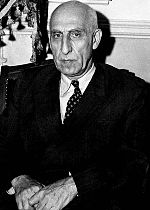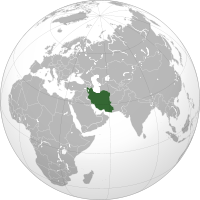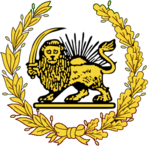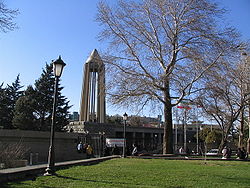- Portal:Iran
-
- Wikipedia portals:
- Culture
- Geography
- Health
- History
- Mathematics
- Natural sciences
- People
- Philosophy
- Religion
- Society
- Technology
The Iran Portal
خوش آمدید! WELCOME!
Flag of Iran
Coat of arms of Iran Iran, (Persian: ايران, Īrān; pronunciation: [iːˈɾɒn]), officially the Islamic Republic of Iran (Persian: جمهوری اسلامی ايران, transliteration: Jomhūrī-ye Eslāmī-ye Īrān), formerly known internationally as Persia, is a Southwest Asian country located in the geographical territories of the Middle East, Central Asia and the Caucasus. The 18th largest country in the world, Iran is approximately the size of the United Kingdom, France, Spain, and Germany combined and has a population of over 70 million people. Iran borders Armenia, Azerbaijan and Turkmenistan to the north, Afghanistan and Pakistan to the east, and Turkey and Iraq to the west. In addition, it borders the Persian Gulf, an important oil-producing area, and the Caspian sea. Shi'a Islam is the official state religion and Persian the official language. The political system of Iran comprises several intricately connected governing bodies and is based on the 1979 Constitution. The highest state authority is the Supreme Leader, currently served by Ali Khamenei.
Iran has one of the oldest histories in the world, extending nearly 6,000 years, and throughout history, Iran has been of geostrategic importance because of its central location in Eurasia. Iran is a founding member of the UN, NAM, OIC, OPEC, and ECO. Iran as a regional power occupies an important position in the world economy due to its substantial reserves of petroleum and natural gas, and has considerable regional influence in Southwest Asia. Iran is also one of the few states that comprise the cradle of civilization. The name Iran is a cognate of Aryan and literally means "Land of the Aryans."

Selected article
The Lion and Sun or Shir-o-khorshid (Persian: شیر و خورشید) is one of recognized emblems of the Red Cross Movement alongside Red Cross and Red Crescent. It is one of the better-known emblems of Iran, and between 1423 and 1979 was an element in Iran's national flag. The motif, which combines ancient Iranian, Arab, Turkish, Mongol and Jewish traditions, became a popular symbol in Iran in the 12th century[1] The lion and sun symbol is based largely on astronomical and astrological configurations: the ancient sign of the sun in the house of Leo,[1][2] which itself is traced backed to Babylonian astrology and Near Eastern traditions.[2][3]
The motif has many historical meanings. First, it was only an astrological and zodiacal symbol. Under Safavid and the first Qajar kings, it became more associated with Shia Islam.[1] During the Safavid era, the lion and sun stood for the two pillars of society, the state and the Islamic religion. It became a national emblem during the Qajar era. In the 19th century, European visitors at the Qajar court attributed the lion and sun to remote antiquity; since then, it has acquired a nationalistic interpretation.[1] During the reign of Fat'h Ali Shah and his successors the form of the motif was substantially changed. A crown was also placed on the top of the symbol to represent the monarchy. Beginning in the reign of Fat'h Ali Shah Qajar, the Islamic aspect of the monarchy was de-emphasized. This shift affected the symbolism of the emblem. The meaning of the symbol changed several times between the Qajar era and the 1979 revolution. The lion could be interpreted as a metaphor for Ali, for the heroes of Iran who are ready to protect the country against enemies, or for its ancient meaning as the symbol of kingship. The Sun has alternately been interpreted as symbol of the king, Jamshid, the mythical king of Iran, and the motherland.
The many historical meanings of the emblem have provided rich ground for competing symbols of Iranian identity. In the 20th century, some politicians and scholars suggested that the emblem should be replaced by other symbols such as Derafsh-e-kaviani. However, the emblem remained the official symbol of Iran until the 1979 revolution, when the "Lion and Sun" symbol was removed from public spaces and government organizations, and replaced by the present-day Coat of arms of Iran.
selected picture
Things you can do
 This is just a start of the 'Iranian Wikiportal. Much remains to be done. Please pitch-in! See also:
This is just a start of the 'Iranian Wikiportal. Much remains to be done. Please pitch-in! See also:- The Iranian Wikipedians' notice board.
- The Iranian "to do" list.
Wikiprojects
- WikiProject Iran
- WikiProject Persian cinema
- WikiProject Persian literature
- WikiProject Zoroastrianism
- WikiProject Countries
Iran News
Regional current events | World current events | More current events on WikinewsSelected Poem
“ بنی آدم اعضای یک پیکرند که در آفرينش ز یک گوهرند
چو عضوى به درد آورد روزگار دگر عضوها را نماند قرار
تو کز محنت دیگران بی غمی نشاید که نامت نهند آدمیHuman beings are members of a whole,
In creation of one essence and soul.
If one member is afflicted with pain,Other members uneasy will remain.
If you have no sympathy for human pain,The name of human you cannot retain.
Saadi ” Selected Biography
Dr. Mohammad Mosaddegh (Persian: محمد مصدّق, IPA: [mohæmˈmæd(-e) mosædˈdeɣ] (
Credit: Amir.Hossein.7055  listen)* also Mossadegh, Mosaddeq, Mossadeq, Mosadeck, or Musaddiq) (19 May 1882 – 5 March 1967) was the democratically elected[4][5][6][7] Prime Minister of Iran from 1951 to 1953 when he was overthrown in a coup d'état backed by the United States Central Intelligence Agency.
listen)* also Mossadegh, Mosaddeq, Mossadeq, Mosadeck, or Musaddiq) (19 May 1882 – 5 March 1967) was the democratically elected[4][5][6][7] Prime Minister of Iran from 1951 to 1953 when he was overthrown in a coup d'état backed by the United States Central Intelligence Agency.
From an aristocratic background, Mosaddegh was an author, administrator, lawyer, prominent parliamentarian, and politician, famous for his passionate opposition to foreign intervention in Iran. During his time as prime minister, a wide range of progressive social reforms were carried out. Unemployment compensation was introduced, factory owners were ordered to pay benefits to sick and injured workers, and peasants were freed from forced labour in their landlords' estates. Twenty percent of the money landlords received in rent was placed in a fund to pay for development projects such as public baths, rural housing, and pest control[8].
He is most famous as the architect of the nationalization of the Iranian oil industry, which had been under British control since 1913 through the Anglo-Iranian Oil Company (AIOC) (later British Petroleum or BP). The Anglo-Iranian Oil Co. was controlled by the British government.[9] Mosaddegh was removed from power in a coup on 19 August 1953, organised and carried out by the United States CIA at the request of the British MI6 which chose Iranian General Fazlollah Zahedi to succeed Mosaddegh.[10] The CIA called the coup Operation Ajax[11] after its CIA cryptonym, and as the 28 Mordad 1332 coup in Iran, after its date on the Iranian calendar.[12] Mosaddegh was imprisoned for three years, then put under house arrest until his death.
Did you know...
- ... that the word Iran means 'The Land of the Aryans'?
- ... that Iran became 9th country in the world to place its own satellite into orbit by using a domestic launcher and the 6th to send animals in space?
- ... that the Behistun Inscription is Old Persian's equivalent of the Rosetta Stone?
- ... that Mashhad is the second largest holy city in the world and Imam Reza shrine is visited by more than 20 million pilgrims every year?
- ... that Astan Quds Razavi is considered the longest-lasting organization, existing since about 1,200 years ago?
- ... that the oldest traces of wine found in Iran date to over 7000 years ago?
- ... that the first Iranian empire, that of the Medes, was established over 3000 years ago?
- ... that the Persian language is one of the oldest languages in continuous use?
- ... that the notions of heaven and hell are already alluded to in the teachings of Zarathustra?
- ... that several world religions - including Zoroastrianism and the Bahá'í Faith - originated in Iran?
- ... that Iran has the largest Shi'a population in the world with nearly 65 million followers?
- ... that Iran has the 18th largest economy in the world by PPP?
- ... that Persians first dug up the Suez canal, circa 500 BC?
- ... that ice cream was likely invented in Iran?
- ... that Iran is the largest producer of pistachio, berries, caviar, saffron and stone fruits in the world?
- ... that peach, pomegranate and pistachio were first cultivated in Iran?
- ... that the first known electric battery was invented by the Parthians, an Iranian people?
- ... that the words cheque, caviar, caravan, tulip, algorithm, chess, checkmate, jasmine, Navy, Paradise, khaki and pajamas all have Persian roots?
- ... that the Milad tower in Tehran is the 12th tallest freestanding structure in the world and held the title as the tallest tower in the Middle East until the Burj Khalifa passed it?
- ... that Iran is home to the biggest Jewish population in Asia (outside Israel), and there are reserved seats for Christian and Jewish MPs in the Iranian parliament?
- ... that Iran has the second largest oil reserves and the second largest natural gas reserves in the world and is potentially an energy superpower?
- ... that Iran is the largest car manufacturer in the Middle East?
- ... that Iran is amongst the top 10 in the world in stem cell research?
- ... that Iran is one of the largest dam builders in the world?
- ... that Iran is among the first five countries which have had a growth rate of over 20% and the highest level of development in telecommunication in recent years?
- ... that 60% of students enrolled in Iranian universities are women?
- ... that Iran has the highest academic publishing growth rate in the world and its science progress growth is fastest globally?
- ... that more than two-thirds of the 70 million Iranians are under the age of 30?
- ... that the history of Iran goes back nearly 5,000 years?
- ... that Iran has one of the largest troop mobilization in the world with nearly 1 million on active duty?
- ... that the UN's General Assembly recognizes the International Day of Nowruz, describing it a spring festival of Persian origin which has been celebrated for over 3,000 years?
Categories
Iran • Architecture • Art • Cities and towns • Culture • Economy • Geography • Government • Mosques • History • Military • Music • Transportation • People • Politics • Universities and colleges • World Heritage Sites in Iran •
Featured content
Iran topics
Associated Wikimedia

Iran on Wikinews
News
Iran on Wikiquote
Quotes
Iran on Commons
Images
Iran on Wikisource
Texts
Iran on Wikibooks
BooksIran Related portals
Portals of neighbouring countries or Iranian Cities 






Afghanistan Armenia Azerbaijan Iraq Pakistan Turkey Nishapur Other related portals 




Islam Kurdistan Assyrians Zoroastrianism Bahá'í Faith
Cite error: There are<ref>tags on this page, but the references will not show without a{{Reflist}}template or a<references />tag; see the help page.Categories:- Iran
- Middle Eastern portals
- WikiProject Iran
- Portals by country
Wikimedia Foundation. 2010.





